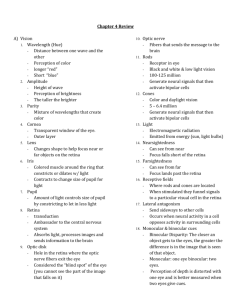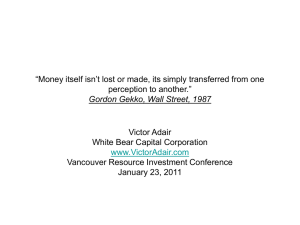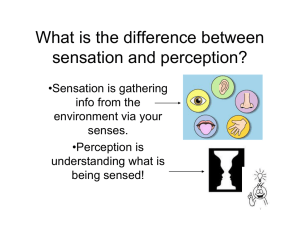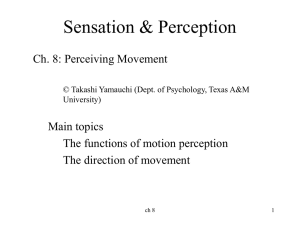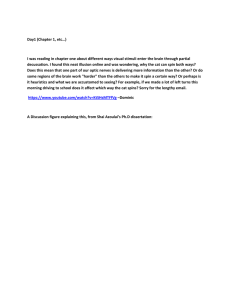Motion Perception
advertisement
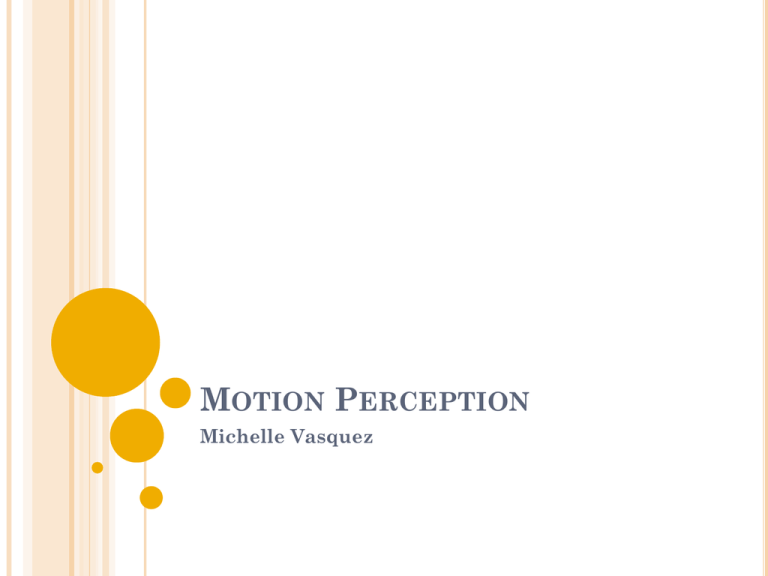
MOTION PERCEPTION Michelle Vasquez MOTION Defintion: change in an object’s location over time First order motion: change in luminance Second order motion: contrast and texture change MOTION CIRCUIT (SIMPLIFIED) Barlow and Levick (1965) D allows a delayed response so A and B can fire simultaneously Cell X (multiplication cell) fires if both B and D fire simultaneously, passing the message on to the motion detector cell, M MOTION CIRCUIT (LESS SIMPLIFIED) Here is a less simplified version of our motion circuit: White: object we see Blue: object’s path of motion Red: delay cells Purple: multiplication cells Green: motion detector EDGES OF RETINA The edges of our retina are sensitive only to movement No color or object identification When the movement stops, the object becomes invisible Example: waving hand around the side of your visual field RETINA The retina is stimulated by the moving of images Image-retina movement “on-off” receptors respond when a change in illumination occurs Movement coded as neural signals in the retina, or in the visual projection areas of the brain Image runs across the retina sequentially fires receptors in its path The faster the image travels, the greater the velocity signal this will give MIDDLE TEMPORAL LOBE The middle temporal lobe is also known as MT or V5 External motion primary visual cortex middle temporal lobe Most neurons here are selective for motion in one direction and do not show much sensitivity for color or form EYE-HEAD MOVEMENT Eye following moving objects The fact that the eye is being moved is signaled to the brain and used to indicate movements of external objects It seems easy to detect if movement is due to our own motion among surrounding objects or due to their movement if we are moving (if our legs are moving) But what if you are in a car? The only source of info is from our eyes. (Keep this in mind when we talk about motion paradox.) WHAT IS MOVING? Saccade suppression: reduction of visual sensitivity that occurs when one makes a saccadic eye movement Eliminates smear from retinal image motion during eye movement o Saccade and smooth pursuit work together so there is no sudden displacement of objects in front of you Comparator: area of visual system that receives one copy of the order issued by the motor system when the eye moves (the other copy goes to the eye muscles) Compensates for image changes caused by eye movement EYE MOVEMENTS The superior colliculus is responsible for initiating and guiding eye movements 3 types: Smooth pursuit: type of eye movement in which the eyes move smoothly to follow an object Vergence: the two eyes move in opposite directions Saccade: rapid movement of the eyes that changes fixation from one location to another (also seen in REM sleep) EXAMPLE Moving your eyeball with your finger, no signal sent from eye muscle to comparator, therefore visual input visual input interpreted as shaking world WHAT DO WE USE MOTION PERCEPTION FOR? Navigation We want to determine what is moving and what is stationary to be able to navigate around Identifying objects “biological motion”- pattern of movement of living beings (humans and animals) We want to identify moving objects and their actions Avoiding collision Ration of retinal image size at any movement to the rate at which the image is expanding BIOLOGICAL MOVEMENT http://www.lifesci.sussex.ac.uk/home/George_Mat her/Motion/ ILLUSIONS OF MOTION Waterfall effect We already know that cells respond to motion in one particular direction Motion after affect After viewing motion in a constant direction for a sustained amount of time (15 seconds or so), we see stationary objects moving in the opposite direction http://www.lifesci.sussex.ac.uk/home/George_Mather/Mot ion/ APPARENT MOTION The impression of smooth motion resulting from the rapid alteration of objects that appear in different locations in rapid succession http://www.lifesci.sussex.ac.uk/home/George_Mather/ Motion/ MOTION PARADOX (PARALLAX) When we move (ex: to the right), near objects move against our motion (to the left) and further objects seem to move with us (to the right) Ex: the moon when driving in a car The moon is so distant that its angular position does not change, yet it appears to be not so far away Therefore, we ‘assume’ it is moving with the car SUMMARY Motion information helps us determine where objects are going and when they are likely to get there There is a motion detection circuit that uses both delay and sum information The middle temporal lobe is involved in perception of motion Eye movement v. object movement is distinguished by the suppression of motion signals generated by eye movements so everything is not ‘smeared’ CREDITS Sensation & Perception by Jeremy Wolfe and others. (Sinauer, 2006) Eye and Brain by Richard Gregory. (Princeton University Press, 1997) The Student's Guide to Cognitive Neuroscience by Jamie Ward. (Psychology Press, 2006) “Introduction to Motion Perception” http://www.lifesci.sussex.ac.uk/home/George_Mather/Motion/ (George Mather, 2008) "Perception (psychology)" http://encarta.msn.com © (Microsoft Encarta, 1997-2009) “Motion Perception, Elementary Mechanisms” http://wexler.free.fr/library/files/burr%20(0)%20motion%20perceptio n,%20elementary%20mechanisms.pdf (David C. Burr, 2003) “Motion Perception” http://vision.rutgers.edu/klab/research/motionPerception.htm (Tom Albright, Richard van Wezel, Karen Dobkins, Amy Rezec, 2008) “Sensation and Perception” http://www.sinauer.com/wolfe/chap7/startF.htm (Sinauer, 2006) THANKS FOR YOUR ATTENTION The end!





